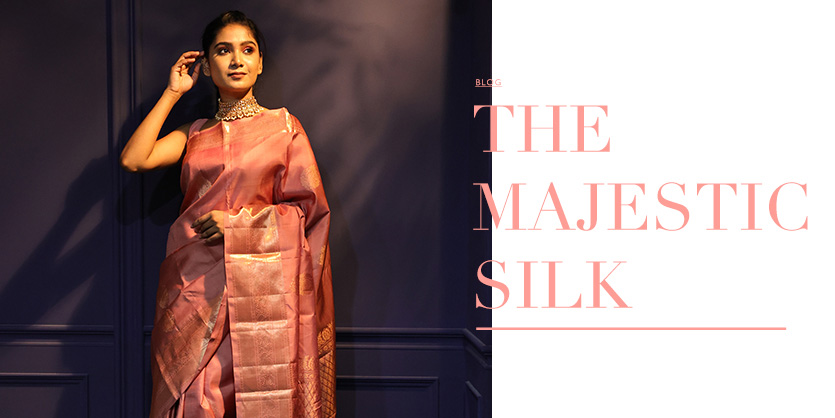
The Silk Family
Saree is a traditional expression of the cultures and ethnicities that mark our country. The classiness of a saree is unparalleled and that is why all of us love this exceptional attire.
As an eternal ethnic piece of clothing, a wide variety of Sarees can be found across the length and breadth of our Country. The standard six yards of drape can be modelled and fashioned variedly depending on the diverse types of sarees in India.
Our rich nation has given us many languages, foods, and even categories of Sarees! We will take you on a journey one Saree at a time!
Learn about the significance of different types of Saree. The next event you show up to is going to be a style-packed event as you parade your new sense of ethnic pieces of clothing.
Vivacious colours, majestic borders, and rich silk give Kancheepuram Saree a rich aura.
Hailing from Tamil Nadu, Kancheepuram are traditional bridal sarees that have been adopted all over the country for wedding occasions. Weaved from pure mulberry silk thread, the sarees have an innate elegance and grace to them. The sarees have a signature gold tint to elaborate their look.
It also fashions religious motifs inspired by the temples and mythological tales. The pallu of the silk saree is usually a contrasting colour adding more essence to the texture of the drape.
From all the different types of sarees at Pothys, the Organza saree is very distinguishable. This textured saree is elegantly personified.
The Organza saree is a staple in every women’s wardrobe. It is woven from a very breathable material making it wearable in humid weather.
This lightweight saree has zari work with the pallu being heavily designed but in modern days, hand-printed Organza sarees are much in vogue.A timeless piece of fashion, Organza sarees can be styled with straight hairstyles and minimal jhumkas.
Tussar silk is also known by the Sanskrit name, Kosa silk sarees. They are made from silk that is produced from silkworms resulting in beautiful patterns. Tussar silk sarees come in floral motifs and even geometrical shapes.
The extensive detailing of the Tussar silk saree is crafted through darn stitches on the coarse side of the fabric.
Tussar silk designs are extremely attractive owing to the natural coloured cloth that is used. Different types of Sarees fall under the broader Tussar silk spectrum based on production. Kundan jewellery looks ethereal with Tussar silk sarees with a high bun hairstyle tucked with a couple of roses.
The pristine shine of Parampara Pattu Saree from Pothys is exquisite.
The silk and zari are woven intricately making the fabric light as air. The luxurious texture of the saree makes it apt for festivities and celebrations.
There are different types of wearing saree and in all of them, the lustre of Parampara never gets dim. The Parampara handloom weave is a scrumptious texture making this drape a showstopper at any wedding function.
Style tip: The Parampara Saree can be fashioned with a slick back hairdo and Kundan jewellery.
Looking at all the different fabrics and styles we have figured out one thing, the saree names and texture may differ but their feel is tethered to our all-embracing culture.
Give a missed call to 1800-315-3131 (All India) or get in touch with us on +91 9620955555 (Bangalore) and +91 9176833316 (International customers) to shop with us from the comfort of your home. Our sales representatives will walk you through the store virtually!








